The Rosen Outdoor Sculpture Competition & Exhibition is a national juried competition presented annually by the Turchin Center for the Visual Arts on the campus of Appalachian State University in Boone, North Carolina. The Rosen has become an integral part of An Appalachian Summer Festival, the university’s annual multi-arts celebration presented by the Office of Arts & Cultural Programs.
Welcome
Welcome to the Twentieth Rosen Outdoor Sculpture Competition and Exhibition. With great pride, we celebrate this milestone anniversary for one of our most exciting visual arts programs on campus. This program, used as a model by arts organizations throughout the country, has always been about partnership – partnership with Martin and Doris Rosen, without whom it could not be possible; partnership with the wonderful artists who have joined the competition and those who have been selected for the exhibition; and partnership with those who have worked tirelessly behind the scenes. On behalf of the Appalachian Family, I extend my congratulations and deepest thanks to all of you.
Appalachian State University is honored to host this twentieth installation of sculptures which brings ten new outstanding public works of art to our community, and over the years has been responsible for installing more than 200 sculptures on the campus. The university has been acknowledged for its public art and we are pleased to continue to use our campus as a venue for works from creative artists all around the country. Enjoy!
Dr. Kenneth E. Peacock
Chancellor, Appalachian State University
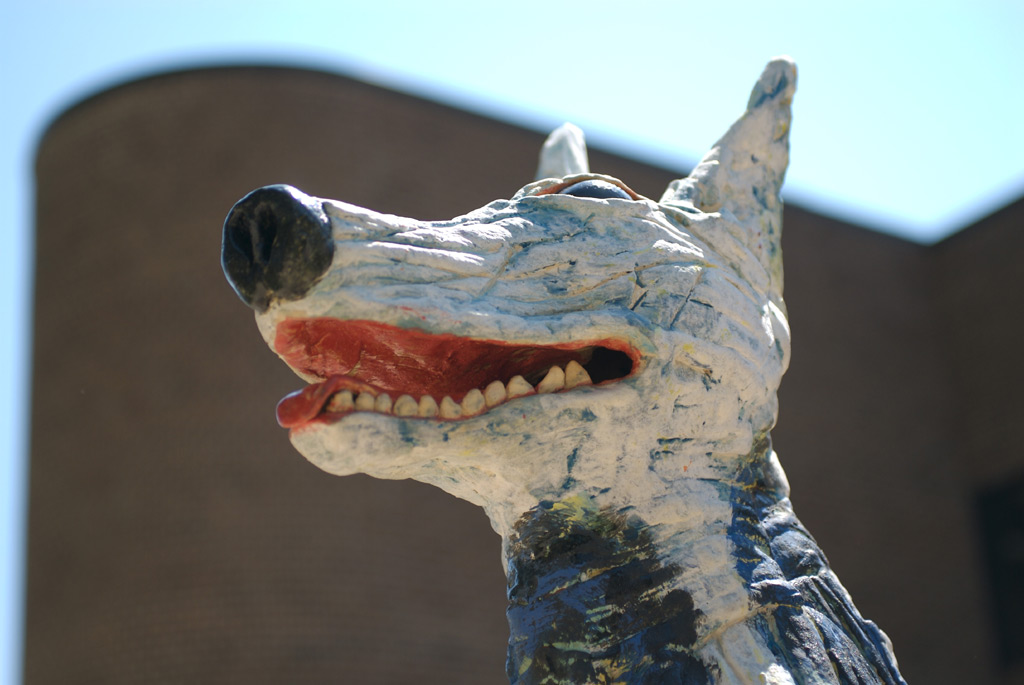
Jeff Downing, Block Island Hangout. 20th/2006 Rosen Sculpture Competition Winner.
Sculptures
Block Island Hangout
Jeff Downing
San Rafael, California
Ceramic
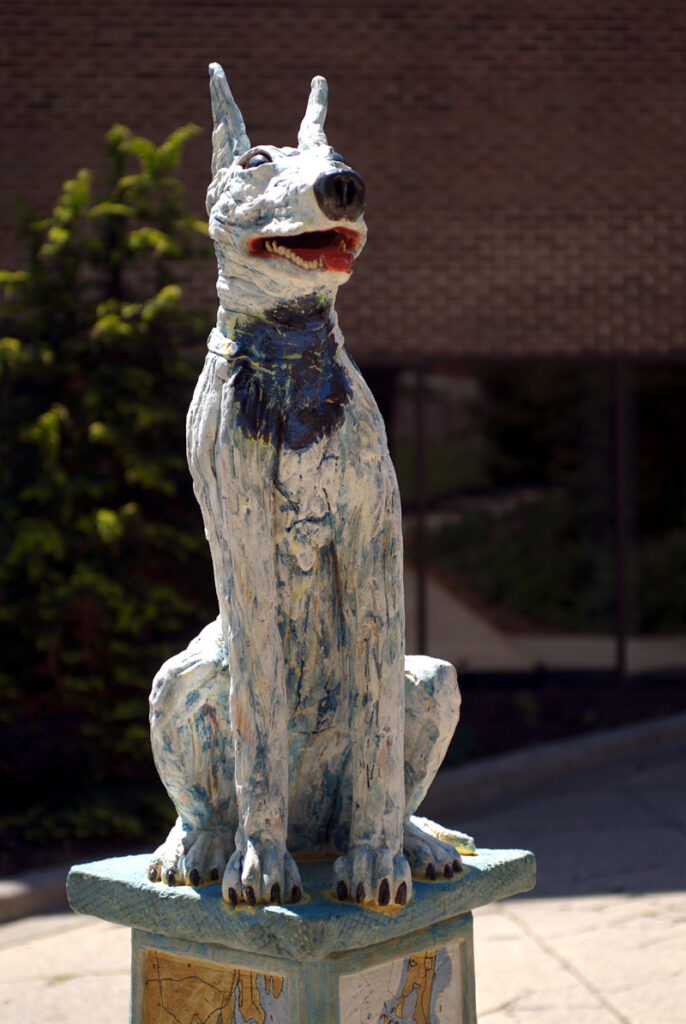
Artist statement
I discovered the art of ceramics in 1982 while studying music composition at the State University of New York at Purchase. The first ceramics class I took proved so rewarding from a creative standpoint that it altered the course of my studies inspiring me to pursue a career as a ceramic artist. Working with clay liberated me from the collaborative process and the regiment of structured music. I was searching for a way to express my ideas without boundaries and I found it with ceramics.
Drawn to the spirit of experimentation and nonconformity that characterizes art and artist in California, I moved to San Francisco where I became exposed to a broad spectrum of ceramic sculpture in the region. I was especially inspired by the work of California ceramicist Robert Arneson. I studied with several well known ceramic artists in the San Francisco area including clay and bronze sculptor Steven DeStabler. In 1996 I began teaching ceramics courses at various institutions and I’m currently working as an Assistant Professor in the ceramics area at San Francisco State University. While my main creative focus is on ceramics, I still continue to make music. I founded several rock bands in the 1990s performing weekly shows for audiences on the local club circuit.
As a way of documenting occurrences significant to my development as an artist, I Work in the narrative with the use of metaphor in attempts to reinterpret life experience into sculpture. My process of working with clay can be described as fluid and spontaneous. Inspired by childhood memories, dreams, imagination and music, the originality of each sculpture stems from an improvisational approach. The forms emerge from a swift process of modeling the clay allowing the natural qualities of the material to guide the composition. The true potential of this method of working is realized when I have successfully integrated ideas with chance discovery.
My work often includes images of dogs. In art the use of dog imagery is part of a long and enduring tradition throughout the world that has characterized the animal for their many symbolic and formal qualities. The affinity I have for dogs stems from a lifelong fascination with their expressiveness, intelligence and sensitivity. In studying the dog, my aim is to develop a better understanding of the connection between our society and the natural world. For as long as we have co-existed with animals, dogs have provided us with a close link to nature. They are the most expressive of the corollary emotions and needs of humans and animals because they have adapted an intuitive communication between our two disparate worlds.
The work “Block Island Hangout” pays homage to the dog’s role in our society to function as a guardian and protector of people and places that are important to us. The nautical charts and mapping lines on the piece reference sailing destinations to historic safe harbors significant to many experiences gained in my formative years living close to the shore on the New England coast.
Appalachian Shade
Martine Kaczynski
Brooklyn, NY
Cinder block wall and canopies
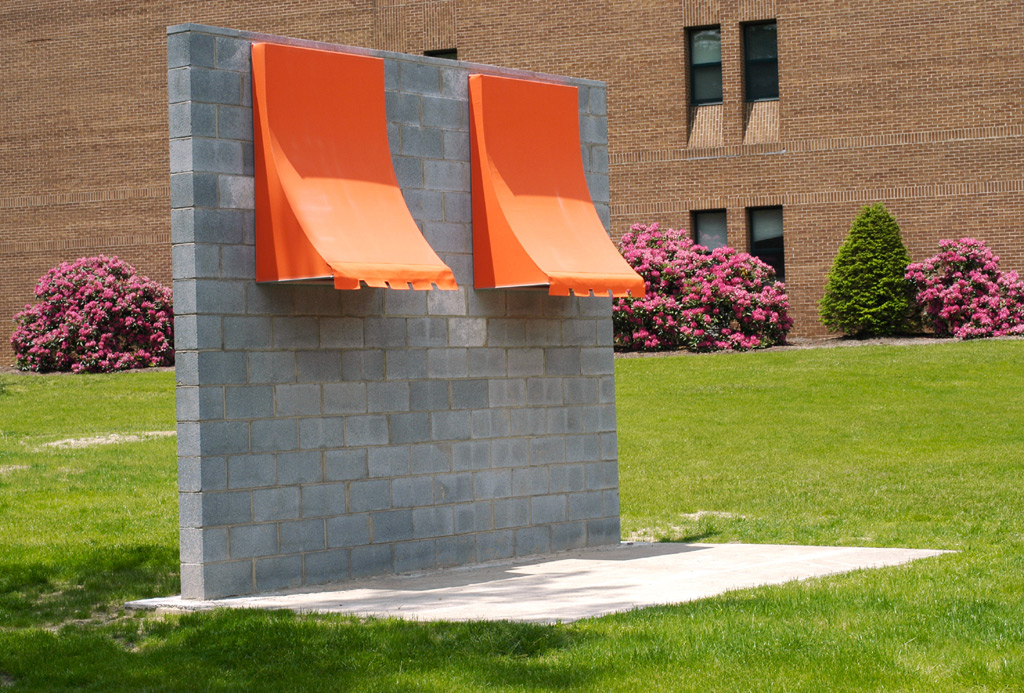
Artist statement
My work explores the transient nature of how we build and relocate our lives while simultaneously striving to recreate the means and markers of settlement and security.
Recently I have been influenced by the architecture in my neighborhood. The borders of people’s homes are marked with precision, but the limits are continually being expanded with adjustable canopies, patios, ponds, and gardens fences. They map out territory and ownership, and although such features have been domesticated, they are constant reminders for me of castles stonewalls and moats.
The canopies pay homage to both the tents of our most nomadic way and the fortress’s of our most settled way.
‘Appalachian Shade’ is caught in the threshold between something that has yet been built and finished, and the residue of something that once was.
3 Ton 1 Ton
Harold “Skip” Van Houten
Ellisville, Mississippi
Cast iron and steel
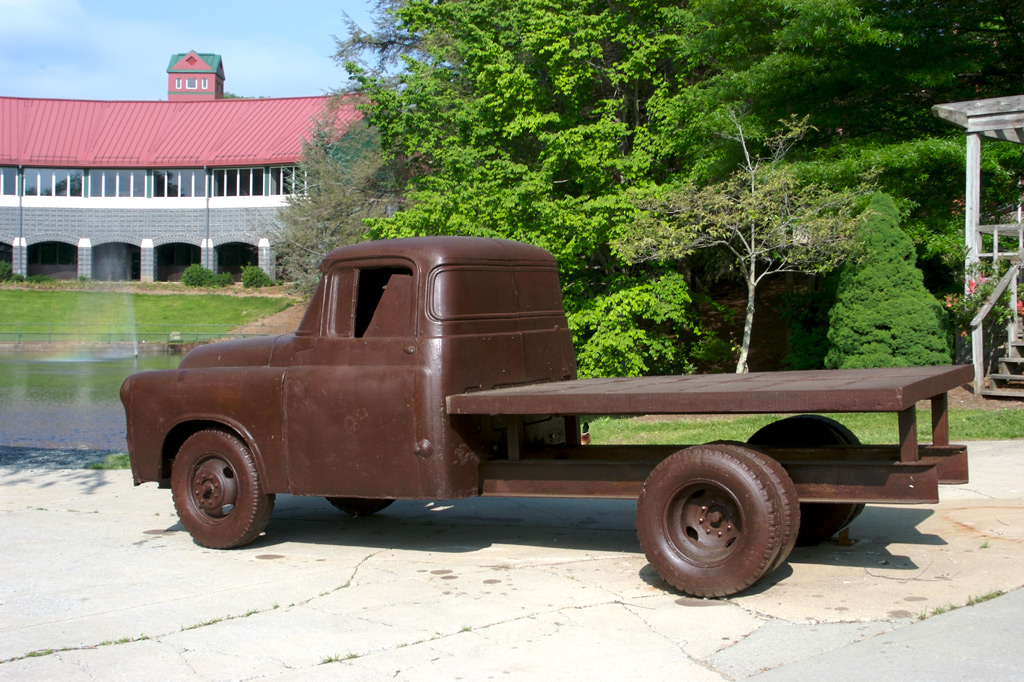
Artist statement
I’ve delivered my formal abstract sculpture on several different trucks throughout my sculpture career. There always seems to be a relationship between the sculpture and the truck. The sculpture now has wheels. The work looks better on the truck than on the ground. The truck has become part of the sculpture. The truck is the art.
This piece is a bridge between abstract sculpture and a love for old trucks, tools with wheels.
Column to Brancusi in the High Federal Style
Darryl Lauster
Houston, Texas
Slipcast porcelain and steel
8′ x 4′ x 4′
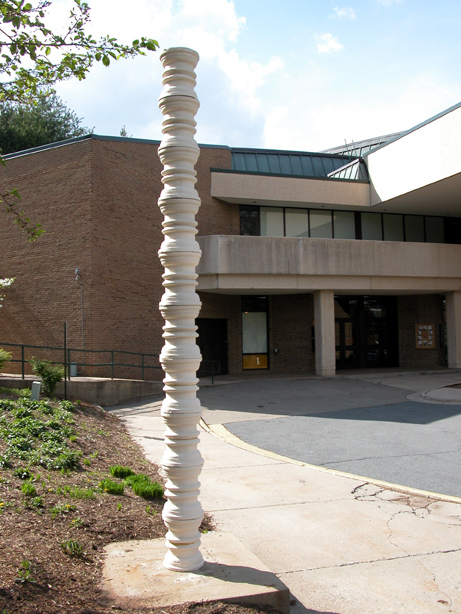
Artist statement
For the past five years my work has derived from an extensive research of early American craft, particularly 18th and 19th century decorative art. At the time, my initial interest in these artisans lied in their unwavering commitment to craftsmanship and the purity of form. I have since come to realize that American silversmiths, potters and cabinetmakers are an integral part of the great legacy of twentieth century modernists such as Donald Judd, David Smith and Alexander Calder. I am interested in form, but also interested in the function of objects within a respective culture. The concept that American decorative art functioned on important sociological levels is largely forsaken within the academia of art history. These objects speak of wealth, social status, heritage, morals and values in a culture whose idealistic origins lie in the concepts of equality and freedom, but whose practical reality was quite different. Through the process of re-examining American history, one can attempt to unravel the distinctions between appearance and reality, particularly within the parameters of public image and public display. I cast objects in resins to leave a ghostly surrogate of objects that once spoke indirectly of an historical identity. I believe this highlights both the social connotations of these works within their respective time periods, but also speaks to our modern world and the technology of our time. My most recent porcelain work is an endeavor to marry Neo-Classical form, a unique artistic movement in that it was inherently political, and most successfully examined in America through architecture and the decorative arts, with the grand theories and formal signatures of Modernism. I am happy to speak of provenance, of telling cultural and social signifiers. I am happy to remark on the curvature of a line, the balance of a foot, formal concepts long understood by craftspeople predating Greenberg. I am happier still to revive the work of artists who continue traditions deserving of a more focal point in the history of American art. This work has offered me a sense of place-linking the past with the present. I continue, in a way, dissecting a collective history, communicating in contemporary forms the traditions begun centuries before me.
Flaneur
Stanley Wrzyszczynski
Granville, Ohio
SPF construction grade lumber
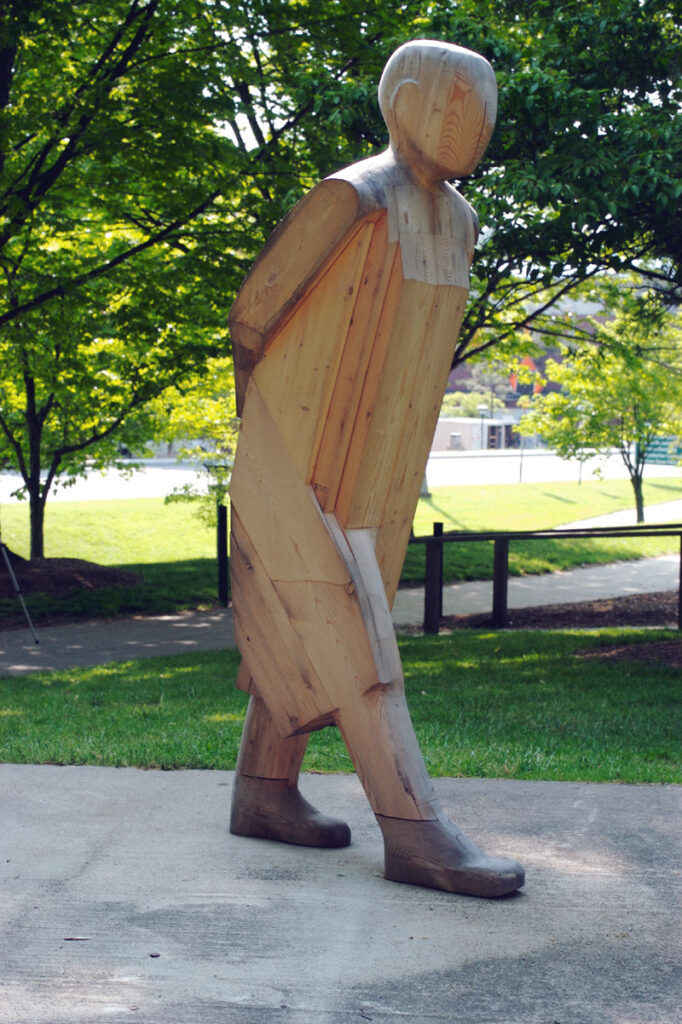
Artist statement
It is an honor to be included in the 20th Rosen. I have great admiration and appreciation for the Rosen’s and the Turchin gifting the Appalachian State community with 10 new sculptures blooming fresh with each new spring. It is very surprising to find my work in the company of such great outdoor pieces.
My work makes no pretension to being lasting or permanent. It is made of ordinary material using ordinary processes. The sculpture itself is the history of its production as well as its exhibition by displaying joinery, cracks, stains, residues, and discolorations.
Tension and contradiction of the subject/object bifurcation through the figure of the body is one focus of my sculpture. Surreptitious displacement of the subject through the guise of generic body language, pose, and gesture is undermined through the presentation of the figure in gestures or poses of ambiguous or ambivalent determination. It is within this “gap” that the subject’s displacement becomes apparent and the subjective implication of the object presents itself.
Four Part Harmony
Carl Billingsley
Ayden, North Carolina
Steel
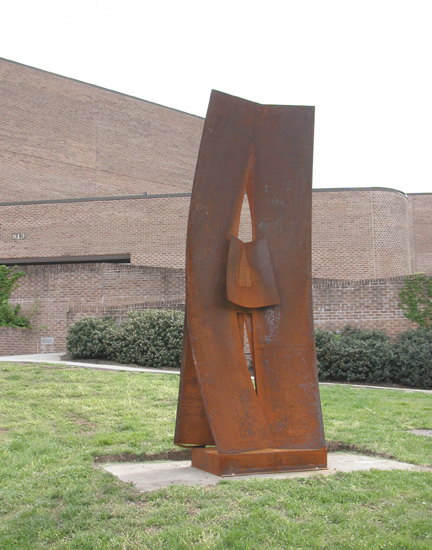
Artist statement
My current work is equally divided between large-scale fabricated metal sculptures for public sites and smaller cast metal sculptures for more intimate spaces. All of my work is abstract, although the inspiration or reference for the work might be the human form, architecture, landscape, or pure geometry. I use materials as directly as possible and am interested in the inherent qualities of the materials showing in the final work. I am deeply involved in making the work and like to allow the different processes of creating the sculpture to be seen in the work. Metal casting, direct carving in stone, welding steel, all have a nature of action, which must be respected. I work within that realm of the physical because I am fundamentally a maker of objects. The sculptures that result from this action usually have a certain ambiguity or contradiction of meaning/form. References, metaphors, associations, and echoes of things seen are all within the work, awaiting discovery by the viewer.
About the artist
Carl Billingsley was born in Oklahoma and spent his formative years in a variety of locations as his father, a sergeant in the field artillery, was transferred from post to post. Three years in Germany made an indelible impression on Billingsley and he has returned to Europe as an adult many times. Billingsley teaches sculpture at the School of Art & Design, East Carolina University and has a very active exhibition schedule. Billingsley’s work can be found in collections and sculpture parks from North Carolina to Wisconsin. He has permanent public sculptures in Norway, Israel, Estonia, Japan, China and Brazil.
For more information, visit www.billingsleyatelier.com.
Moonflower
Christopher Ray
Swarthmore, Pennsylvania
Fiberglass
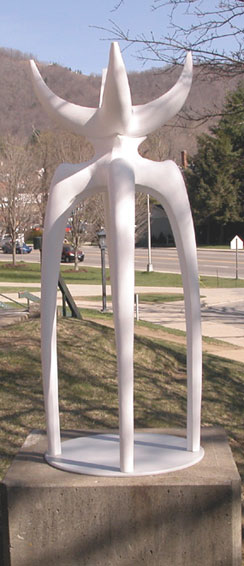
Artist statement
When someone asks me if I like sculpting, it’s similar to someone asking me if I like to breathe. It’s something I do. I have made sculptures and models since I was about five. For the past forty-two years I have been developing abstract pieces, many of which are intended for landscape sale. Certain full, curvy shapes with edges appeal to me, sort of in the shape family of sand dunes. I work in plasticene, plaster, wax, paper mache, bronze, wood, ceramics, concrete, and fiberglass. Soon I hope to have my pieces made in stone. I’m planning floating sculptures, enclosed sculptures for autistic children, and sculptures responding to wind, rain, and sun.
Watch Your Head
Gordon Chandler
Carollton, Georgia
Steel
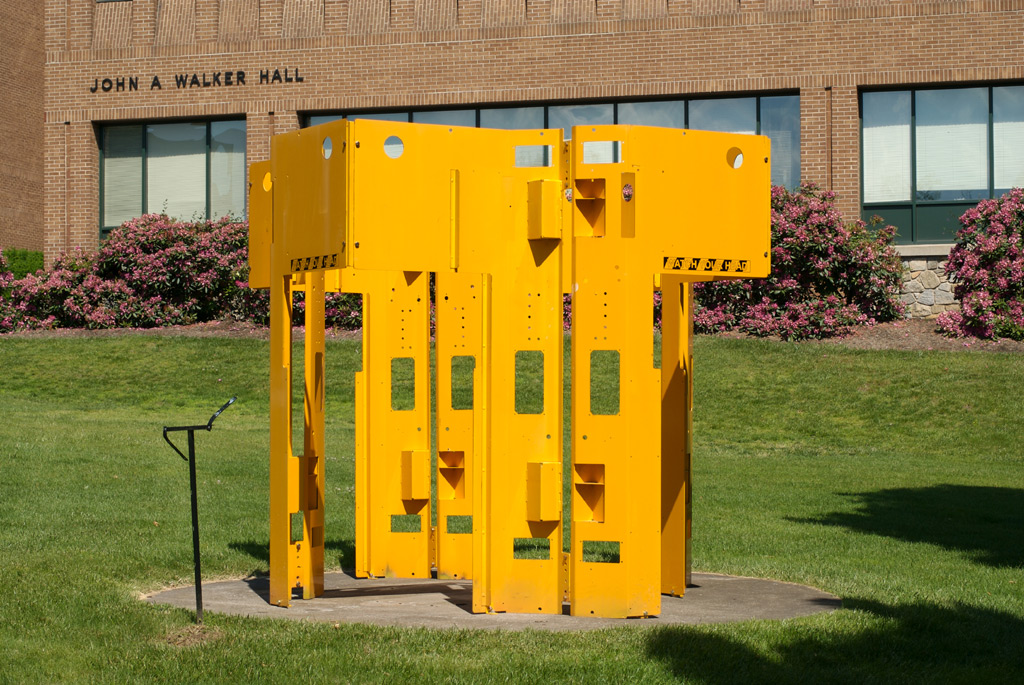
Artist statement
We live in a transient world. Broken things are not fixed – they’re thrown away. I create from the refuse of industry. I work from found materials with intriguing surfaces. They have a history to share … a story to tell.
I seek inspiration in scrap yards, roadsides and from my own previously collected palette. I am inspired by our cultural landscape, materials thrown away in an increasingly disposable world. I alloy these cast off objects into a sculptural form. I like the elements in my work to be mostly unrecognizable; obviously from a different utility and not without some history. The color of paint is best when it is aged and faded and full of character. New paint is less appealing, yet hopeful.
About the artist
Phil Proctor is an artist who has been living and working in southeast Atlanta for the past five years. Originally from south Mississippi, he holds a BFA from the University of Southern Mississippi and an MFA from East Carolina University. Proctor has permanent sculpture installations throughout the southeast as well as in other countries across Western Europe. In 2003 Phil was commissioned by a private development group in conjunction with the City of Atlanta and Marta to design and construct a public artwork, Linkage, which now stands at the Lindbergh City Center Marta station. In 2008 Proctor received another commission from the city of Atlanta to design and build a 22′ tall kinetic sculpture for South Bend Park scheduled for installation in mid 2009.
For more information, visit www.philproctor.com.
Surplus XV
Tom Matthews
Lubbock, Texas
Plastic and steel, site specific
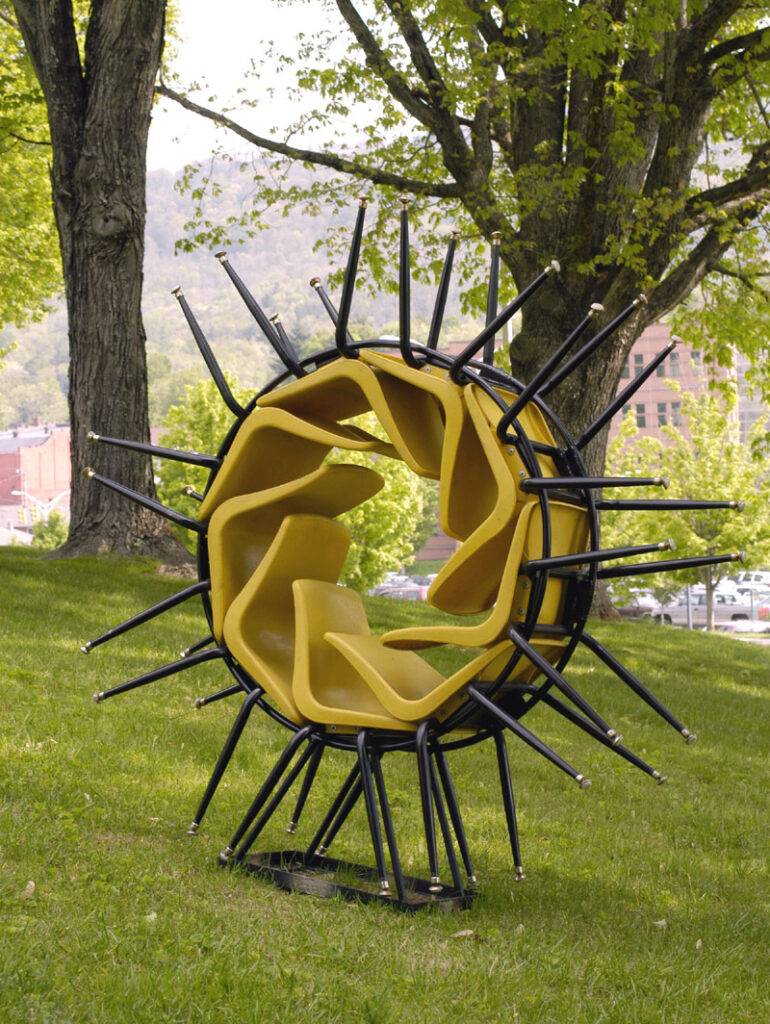
Artist statement
I use mechanically reproduced pedestrian items such as surplus chairs to construct sculpture. I strive to create work that others can relate to. I do not alter the discarded materials; instead I choose to orchestrate their orientation into a rhythmic pattern of formal symmetry using space, line and shape to create the aesthetic.
Through the use of scale, color, geometry and whimsy the chairs transform from a utilitarian functional piece of furniture into a physical manifestation created by my sensibility of the space they occupy.
What is not present is as important as what is present. The lives that occupied the chairs at any given time and place and how those moments may have impacted their past, present and future all enter into the synthesis of ideas which direct the physical realization of the sculptures.
The material’s form is predetermined. I use that form within the architectural boundaries of a given space along with improvised rules to construct new forms. These forms may appear to be manufactured, yet they are the opposite. The chairs I use are mass-produced. They are designed and intended for one purpose. By using multiples creating patterns, rhythms and repetition I create a single form from the masses.
Withering Marker
Margery Evelyn Albertini
Richmond, Virginia
Steel
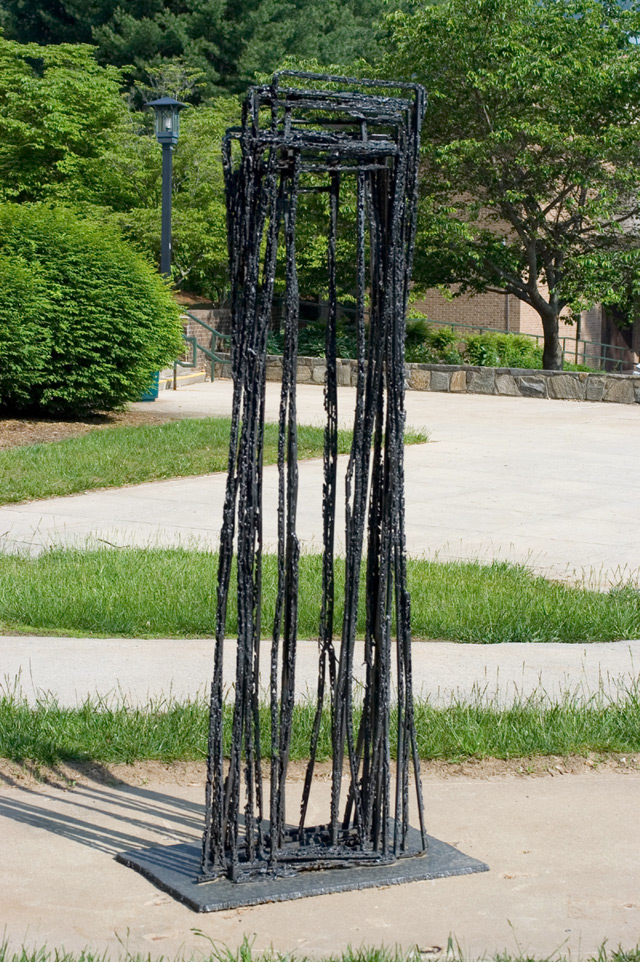
Artist statement
I am intrigued with the play of opposites: beautiful and grotesque, attraction and repulsion, as well as the fine line that lies between the two. My art draws from recurring themes of irony, vulnerability, conflict, sensuality and asceticism. I begin a sculpture by working intuitively with an immediate and aggressive response to materials. Then I carefully examine, dissect and rework the piece. The resulting organic forms refer to the passage of time and depend upon a metamorphosis which reflects a process of movement, growth, and mending. The ultimate character of a piece lies in the transformation of materials resulting in entities which are reclusive and vulnerable yet fiercely independent.
While driving a rural route in upstate New York I saw several beautiful, tall and slender grave markers rising precariously out of the landscape. I stopped to examine them more closely. The rectangular stones were weathered, their deteriorated inscriptions asked to be touched, not read. They stood roughly five feet tall, some leaning forward others tilting backwards. My walk through the quiet grouping felt like a dance, smooth and lyrical. When I faced them individually, the isolated markers felt strong, cool, and sturdy. yet fragile. Each one a “Withering Marker” transformed by the passage of time.
Juror’s statement
What has sculpture become?
Over the course of the last twenty years sculpture has become a more popular, widely discussed and accepted form of art making. It is now the most radical of arts since by definition it encompasses a wealth of approaches, styles, materials and formats. Where casting and carving were the skills associated with sculpture in the past, the definition of the activity would today include almost any action where three dimensional forms were employed. And its proponents no longer distinguish necessarily between figurative or abstract but look to work that somehow resonates with the time in which we are live.
There has been a kind of cultural about face when it comes to sculpture. It has lost much of its macho look and power, to be replaced by a range of approaches and attitudes that focus on the more conceptual side of art making and still brings to bear abstract and figurative ideals as well as architectural assumptions. The openness and freedom is at times overwhelming but it suggests a grand democracy in which all parts of the art equation must be equally considered and included.
With the emergence of environmental and site specific works in the 60s and 70s, the general growth of public art projects and budgets and the building of new museums and gardens the possibilities for sculptors and their vision has grown exponentially. At the same time the radical movements of the previous century whether in the area of Cubism, Futurism or Surrealism all had their sculptural side or hero from Picasso to Boccioni and Man Ray but today that sense of impending stylistic movements or identifiable historic periods has given way to very individual, very personal and at times national talents and responses.
The world has shrunk, or gone flat as the noted journalist Thomas L. Friedman has reported in his 2005 book and in proportion to this phenomenon the borders of style and culture have opened so that the crosscurrents of exchange are ever present. The studio, once the haven for work and ideas, can now be anywhere and production can be any place. The sculptor is a citizen of the world, a practitioner of a myriad of crafts and purveyor of numerous talents called to problem solve and then build.
The definition of what sculpture is has altered too; nothing is left outside the realm of possibilities when sculpture is concerned or sculptors are asked to become engaged with a site, a location, a gallery space or an institution. The emergence of installation works in the last decade as the sine qua non of contemporary art practice owes a great deal to the emergence and legacy of the alternative spaces of the 70s and the energy and passion of contemporary artists willing to build and then see demolished temporary installations. P.S. 1 in New York and 112 Greene Street became the role models for such endeavors in the days before commercial galleries existed or even presented new art. Such organizations, and they grew rapidly across the U.S., were the laboratories for the experiments which would lay the ground work for the creative explosion of the 80s and 90s. By the 80s sculpture was rich, broad, figurative or abstract but generally accepted. It was imagined in a variety of materials, whether these were wood, metal or steel or were inclusive of the developing technologies of video media and computers. In scale sculpture could be Lilliputian or Gargantuan–limited only by budget, skill and ultimately imagination. And most significantly sculpture was now something addressed to an international audience of collectors, critics and curators: German, English and Japanese artists sculptors such as Franz Erhard Walther, Tony Cragg and Tadashi Kawamata were suddenly showing in New York, Los Angeles, and Dallas and American sculptors such as Mark di Suvero, Jonathan Borofsky and Jenny Holzer were being invited to present works in Paris, Muenster and Moscow.
In the decade of the 90s the equation of sculpture became politicized as the content of works addressed social, political and economic issues facing both the artistic community but also communities around the globe. The questions raised by the artist in their respective work or charging the audience to grasp as a result of the work. Race, gender and ethnicity were at the center of the dialogue and debate; the formal apparatus to express these ideas and explore these issues was not a pictorial one as had been in the past but had become sculptural one. Fred Wilson and Elaine Reichek for example, saw the means to this end in dramatic and prosaic installations which explored through objects both found and made the salient issues of their cultural backgrounds. And the political nature of art making and the art business continues to be of great importance especially to sculptors since their work certainly depends upon support from a broad and diverse spectrum of individuals working in either the public or private sectors.
In the first decade of the 21st century everything and anything remains possible.
The Turchin Center’s sculpture program is a great example of this new almost ideal climate. The exhibition program is based on a strategy that thinks globally but acts locally. This 20th Rosen Outdoor Sculpture Competition and Exhibition serves to bring to the community, the region and the state examples of what is happening “in the field”. The diversity of styles and approaches represented here reflects the wider and on going shifts that the interested viewer will find in galleries and museums across the country. It also illustrates very much what sculpture can be.
Michael Klein
Previous Executive Director
International Sculpture Center (ISC)
About the juror
Michael Klein, previous Executive Director of International Sculpture Center (ISC), is a highly regarded writer, curator and arts program director who will serve as the Juror for the 20th Rosen Outdoor Sculpture Competition and Exhibition. Klein went to the ISC in January 2005 from Microsoft, where he served as curator of their art collection since 1999. For the previous six years, he owned the Michael Klein Gallery in New York, where he was instrumental in the early careers of artists such as Cindy Sherman, Robert Longo and James Casebere, as well as Beverly Semmes, Matt Mullican, Jene Highstein, Elaine Reichek and Rita McBride. Klein has been extensively published and has been a regular contributor to Sculpture Magazine since 1996.
As an independent curator and writer, Klein has organized exhibitions specializing in contemporary and 20th century art topics, as well as authored catalog essays, presented public lectures and served as corporate consultant for art acquisitions, commissions and collection management. In addition to regular submissions to Sculpture Magazine, Klein has contributed over seventy-five essays, reviews and feature articles to Art in America, ArtNews, Drawing, World Art and The Art Book, among others. Michael Klein is a member of the College Art Association, on the Advisory Board of On the Boards in Seattle, WA, and on the National Advisory Committee of Graphicstudio at the University of South Florida, Tampa.
About the curators
Hank Foreman
Hank Foreman serves as Assistant Vice Chancellor of Arts and Cultural Affairs as well as Director and Chief Curator of the Turchin Center for the Visual Arts for Appalachian State University. He obtained his M.A. in Art Education from Appalachian, having completed undergraduate studies at the University of North Carolina at Charlotte, with a concentration in Painting and Sculpture. His duties include the administrative responsibilities for An Appalachian Summer Festival, the Performing Arts Series, Farthing Auditorium and the Turchin Center for the Visual Arts.
During his tenure at Appalachian State, Foreman has taken part in the organization of numerous exhibitions, including the associated lectures, symposia, and publications. He has worked closely with the university’s Department of Art, and a wide variety of other campus and community groups, to make gallery resources available to all. One of his earliest exhibitions at Appalachian, Views From Ground Level: Art and Ecology in the Late Nineties, brought internationally acclaimed artists, historians, and critics to the campus and received national attention.
Foreman is also an exhibiting studio artist, and participates in regional and national conferences as a presenter and panelist.
Brook Bower
Brook Bower serves as the assistant curator and administrator for the Turchin Center for the Visual Arts and its staff. She received a BS in Art Management and a BFA in Ceramics from Appalachian State University’s Department of Art in 2001. Bower’s professional activities include curating exhibitions, lecturing, consulting for competition management, serving as a juror for local competitions, mentoring future art management students and managing several national art competitions including the Rosen Sculpture Competition, the Halpert Biennial and the Appalachian Mountain Photography Competition. Bower also serves as the Acting Registrar, providing collections management support for the Turchin Center’s Permanent Collection containing 1,481+ objects and managing the Intra-Campus Loan Program.
Following her undergraduate degrees, she has concentrated on furthering her education by attending conferences, courses and workshops expanding her knowledge of curatorship, exhibition design, and collections management. Bower recently participated in the 2011 SEMC Jekyll Island Management Institute and is currently seeking a Master of Visual Arts Administration, with a focus in curatorial studies, at New York University in New York City. She serves on multiple committees that concentrate on community enhancement utilizing the visual arts and serves as the faculty advisor for the Arts Management Organization (AMO). In addition, Bower is an active exhibiting artist.
Credits / Acknowledgements
On behalf of An Appalachian Summer Festival, the Office of Arts and Cultural Programs, and the Turchin Center for the Visual Arts, I wish to thank all of the artists participating in this year’s competition and congratulate those chosen for the exhibition. Each year the Rosen Outdoor Sculpture Competition and Exhibition is made possible by the generous support of Martin and Doris Rosen. The Rosens are tireless supporters of the arts, and over the years, have given so much of themselves to ensure that the arts become a more integral part of our community. Their excitement and dedication serve as both inspiration and role model. I would like to thank our juror, Michael Klein, for his vision and commitment to selecting a group of significant works for this milestone year.
A heartfelt word of thanks goes to all of this year’s artists for submitting such a wonderful and diverse range of work. Special thanks goes to this year’s Graphic Designer – Catherine “Sunny” Davies, Photographers – Troy Tuttle and Tasha Nunn. Documentation of these exhibitions is such an important aspect of our program. Thanks goes to our Webmaster – Pete Montaldi, for his dedication to preserving the mages and documentation from the past 20 years on the Rosen sculpture website. We extend a very heartfelt thank you to our exhibition Practicum III students: Clare Evans and Taylor Leaf; Exhibitions II students: Jennifer Livingston, Sara Gordon, Joel Lancaster, Dayna Seman, and Emilie Skytta; TCVA Staff: Brook Bower – Assistant Curator, Tasha Nunn – Program Assistant, Paul Grant – Visitor Services, Dr.Gayle Weitz – TCVA Community Arts School Coordinator, Karen Brown – Membership Coordinator, and Sharon Yates – Program Assistant; and our colleagues in the Office of Arts and Cultural Programs and the OACP’s Marketing Team, Megan Hayes and Kelly Broman-Fulks, for all of their hard work and support in helping to make this exhibition a success. Also thanks to the Department of Art’s Sonny Struss and Joe Bigley for their patience and expertise.
Installation on college campus requires a great deal of inter-departmental collaboration, and my thanks goes to Jim Bryan – Grounds Superintendent, Evan Rowe and Beth Clark – Safety Officers, the entire Grounds Department of the Appalachian State University Physical Plant for their cooperation and expertise and for making our campus a beautiful venue for outdoor sculpture.
Hank T. Foreman
Director & Chief Curator
